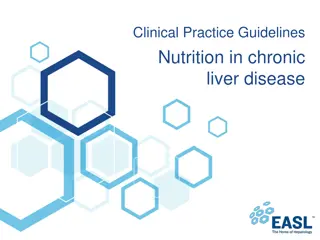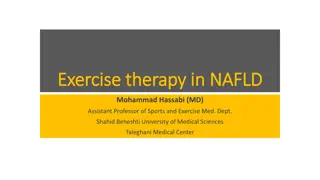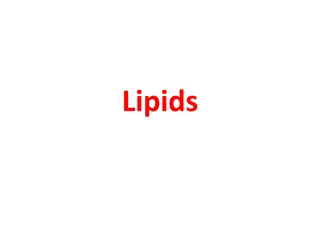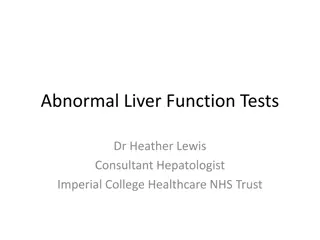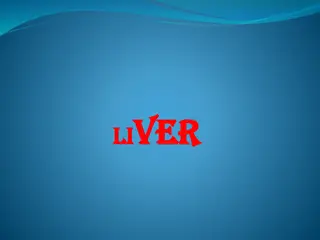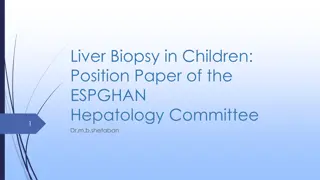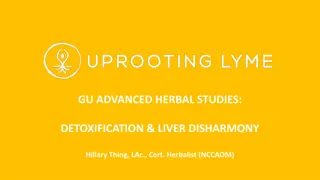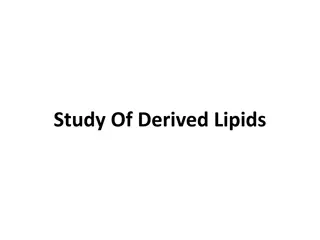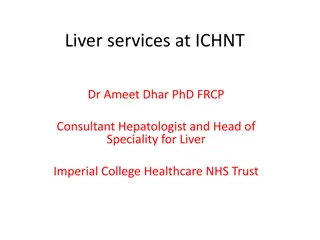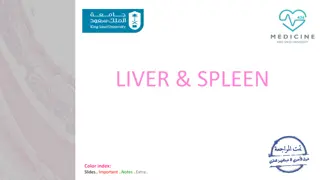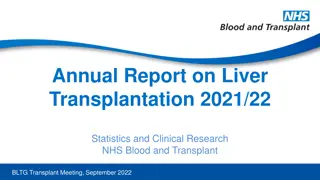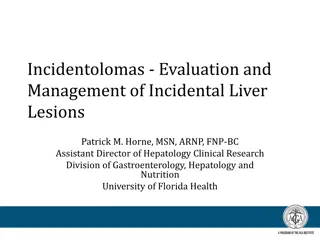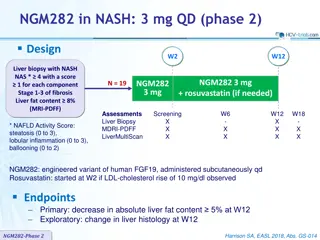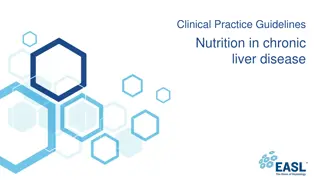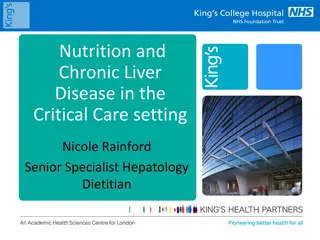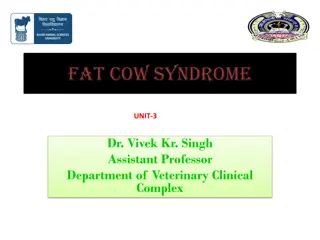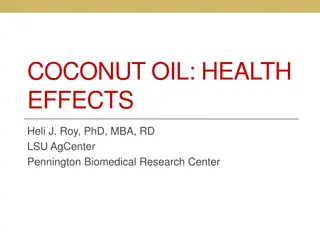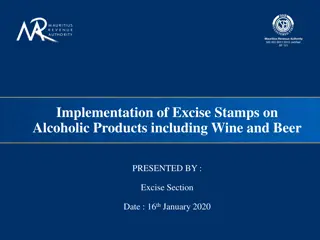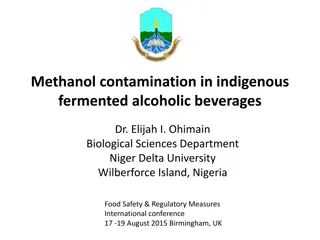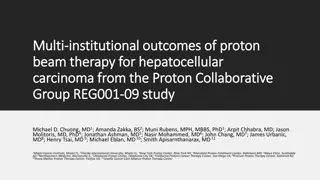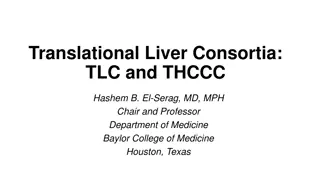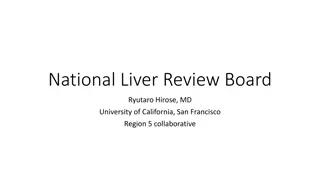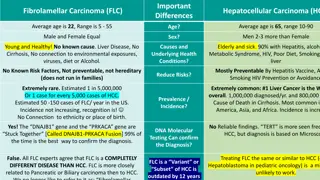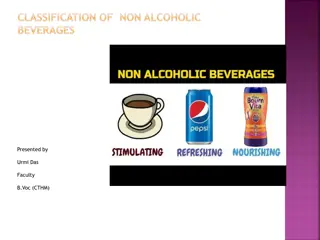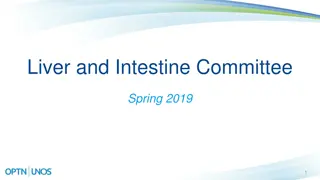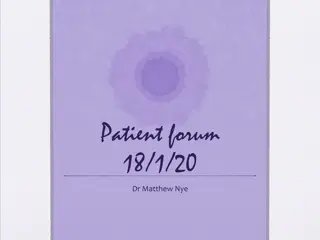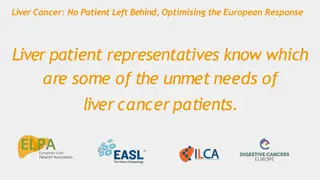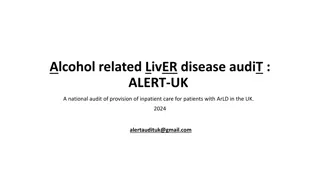Medical Nutrition Therapy in Non-alcoholic Fatty Liver Disease
Medical Nutrition Therapy (MNT) plays a crucial role in managing Non-alcoholic Fatty Liver Disease (NAFLD), focusing on insulin resistance, metabolic syndrome, oxidative stress, dyslipidemia, and cardiovascular risk. Lifestyle recommendations include weight management and increasing physical activity to improve liver health, with studies showing significant benefits of weight loss on reducing NAFLD activity.
Download Presentation

Please find below an Image/Link to download the presentation.
The content on the website is provided AS IS for your information and personal use only. It may not be sold, licensed, or shared on other websites without obtaining consent from the author. Download presentation by click this link. If you encounter any issues during the download, it is possible that the publisher has removed the file from their server.
E N D
Presentation Transcript
Medical Nutrition Therapy (MNT) in Non-alcoholic Fatty Liver Disease Golaleh Asghari Nutrition and Endocrine Research Center Research Institute for Endocrine Sciences Shahid Beheshti University of Medical Sciences 2
Introduction The MNT of NAFLD patients should be based on: Insulin resistance Metabolic syndrome Oxidative stress Dyslipidemia Cardiovascular risk 3
Lifestyle recommendations Usual management of NAFLD includes lifestyle counseling to increase physical activity and achieve gradual weight reduction 4
Lifestyle recommendations Rinella ME et al. Nat Rev Gastroenterol Hepatol 2016, 13, 196 205. 5
Lifestyle recommendations Management of weight and overall fitness is the cornerstone of treatment for all patients with NAFLD. Several studies have demonstrated the benefit of weight loss in reducing steatosis or the NAFLD activity score on histology, with greater weight loss associated with more substantial improvements. Rinella ME et al. Nat Rev Gastroenterol Hepatol 2016, 13, 196 205. 6
Lifestyle recommendations Reductions in ALT levels and steatosis occur even with small decreases in weight, whereas resolution of NASH, or even fibrosis, occurs with more marked or sustained weight loss, such as that observed after bariatric surgery Wong VW, et al. J Hepatol 2013, 59: 536 542. 7
Lifestyle recommendations A prospective study of 293 patients in a community health-care setting demonstrated the effect of weight loss of varying degrees on NASH histology. Monitored diet = comprising a 750 kcal per day reduction from their calculated resting energy requirements. Patients achieved >5% weight loss showed histological improvement. 90% of those achieving >10% weight loss showed resolution of NASH after biopsy. Vilar-Gomez E, et al. Gastroenterology 2015; 149: 367 378. 8
Calculation of Energy Requirement 9
Calculation of Energy Requirement 1- What is Desirable Body Weight? Actualbody weight : if BMI < 25 Adjusted body weight : if BMI 25 Adjusted body weight = current weight - ideal body weight 0.25 + ideal body weight 10
Calculation of Energy Requirement 2- What is Ideal Body Weight? To know how much excess weight an individual has To know how many steps an individual needs to lose weight To calculate adjusted ideal body weight Usually it is BMI=22-23 11
Calculation of Energy Requirement Weight loss of 10% of total body weight over 6 months should be the initial goal. For the next 4-6 months the focus changes from weight loss to weight maintenance. Dietary changes include an energy deficit of 500-1000 kcal/day.
Calculation of Energy Requirement HARRIS-BENEDICT EQUATION FOR CALCULATING THE BASAL METABOLIC RATE Males BMR = 66.5 + (13.8 kg body weight) + (5.0 height in cm) - (6.8 age in y) Females BMR = 655 + (9.6 kg body weight) + (1.8 height in cm) - (4.7 age in y) Caloric needs are calculated by multiplying the BMR by the activity factors: sedentary or little or no exercise, multiply BMR by 1.2; lightly active, light exercise, or sports 1 to 3 days per week, multiply BMR by 1.37; moderately active, moderate exercise, or sports 3 to 5 days per week, multiply BMR by 1.55; heavy exercise, hard exercise, or sports 6 to 7 days per week, multiply BMR by 1.72.
Calculation of Energy Requirement Basal energy expenditure (BEE) BEE = 1 24 (hours) desirable body weight (kg) Male BEE = 0.95 24 (hours) desirable body weight (kg) Female Physical activity level (PAL) Very low: 30% BEE, Low: 50%, Moderate: 75%, High: 100% Thermogenic effect of food (TEF) 10% (BEE + energy for PAL) Total energy expenditure (TEE) = BEE + + energy for PAL + + TEF 14
Example 1 Man with desirable body weight = 77 kg BEE: 1 24 77 = 1848 kcal 1848 30% = 554 kcal 1848 + 554 = 2402 kcal 2402 10% = 240 kcal TEE = 1848 + 554 + 240 = 2642 2650 kcal 15
Calculation of Energy Requirement To simplify: Females TEE = DBW 24 0.95 1.3 (1.2-2) 1.1 Males TEE = DBW 24 1.3 (1.2-2) 1.1
Example 2 28-year woman: Wt = 86 kg Ht = 164 cm BMI = 32 PAL = low 17
Example 2 23 = IBW/(1.64) IBW= 62 kg AIBW = (86 62) 0.25 + 62 = 68 kg 18
Example 2 TEE = 68 24 0.95 1.3 1.1 = 2139 kcal 2100 kcal 2100 2100 500 = 1600 kcal 1600
Composition of diet In addition to total energy intake, the composition of the diet also affects metabolic and endocrine functions, and overall energy balance in NAFLD patients 20
Composition of diet Dietary carbohydrate content has been linked to heightened systemic inflammation and carbohydrate-restricted hypocaloric diets have been associated with greater reductions in hepatic steatosis than a general hypocaloric diet alone Browning JD, et al. Am J Clin Nutr 2011; 93: 048 1052. Browning JD, et al. Hepatology 2008; 48: 1487 1496. Oarada M, et al. Nutrition 2015; 31: 757 765. 21
Composition of diet 22 Rinella ME et al. Nat Rev Gastroenterol Hepatol 2016, 13, 196 205.
Composition of diet Reductions in the intake of fructose Encourage consumption of diets rich in fruits and vegetables. Such diets would provide a significant amount of bioactive components (polyphenols, anthocyanins, and resveratrol ) with known beneficial effects due, in part, to their anti- inflammatory and anti-oxidative properties 23
Composition of diet Reductions in the intake of total fat, saturated fatty acids, trans fatty acids, and cholesterol Excess dietary cholesterol promotes hepatic de novo lipogenesis and increased levels of intracellular free cholesterol that can be cytotoxic 24
Composition of diet Where do Trans fats come from? Food Source Snacks: cakes, cookies, crackers, pies % in Diet 40 21 Animal products 17 Margarine 8 Fried potatoes 5 Potato chips, corn chips, popcorn 4 Shortening 5 Candy, breakfast cereals, other foods 26
Composition of diet Saturated fat: Comparing different foods Foods Amt 1 oz Saturated fat (g) 6.0 1.2 Calories 114 49 Regular cheese Low fat cheese 3 oz 6.1 2.6 Regular ground beef Extra lean 236 148 4.9 2.0 cup Regular ice cream Frozen yogurt (low fat) 145 110 1 cup 4.6 1.5 Whole milk Low fat (1%) milk 146 102 27
Optimal Diet Eating patterns: Low carbohydrate Low fat Low GI (glycemic index) Mediterranean (more vegetables, whole grains, fruit, legumes, nuts, fish, low-fat dairy, olive, and MUFA/PUFA; less red meat and SFAs) Vegetarian 29
Optimal Diet Mediterranean diet effectively reduce hepatic steatosis when compared with an isocaloric low-fat, high-carbohydrate diet. The beneficial effects of the Mediterranean diet on hepatic steatosis were independent of patient weight loss 30
Coffee To encourage patients to drink unsweetened coffee as part of lifestyle modifications to promote a healthy liver, as long as the patient does not have medical conditions that might be exacerbated by coffee intake. 31
Carotenoids Antioxidant micronutrients, such as vitamins and carotenoids, exist in abundance in fruits and vegetables and defend against reactive oxygen species Carotenoids may participate in an antioxidant defense system when free radical species in the liver are present at high concentrations 32
Synbiotic Synbiotic supplementation in addition to lifestyle modification is superior to lifestyle modification alone for the treatment of NAFLD, at least partially through attenuation of inflammatory markers in the body Eslamparast T et al. Am J Clin Nutr 2014;99:535 42. 33
Synbiotic 34
Key Home Message Lifestyle counseling Gradual weight reduction Limit carbohydrate to less than 45% energy intake Limit simple sugars in particular fructose Limit SFA, trans fatty acid, and cholesterol 35





